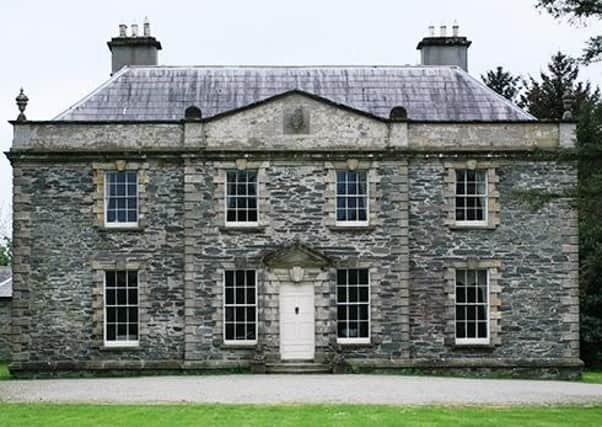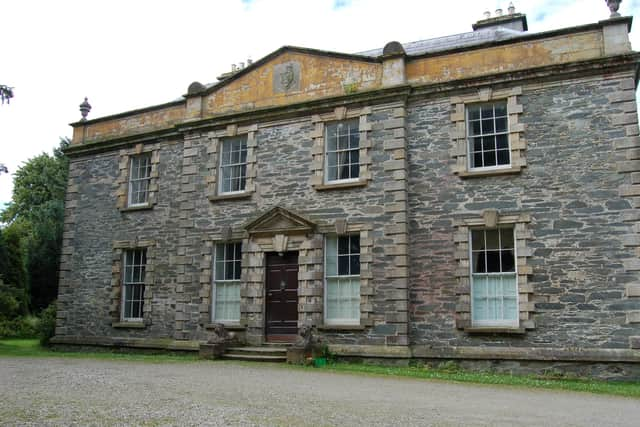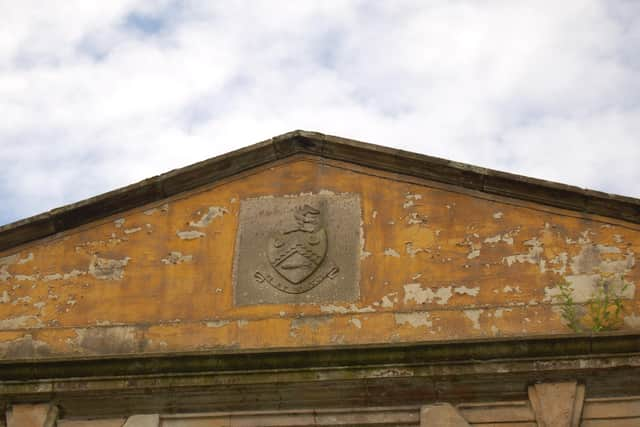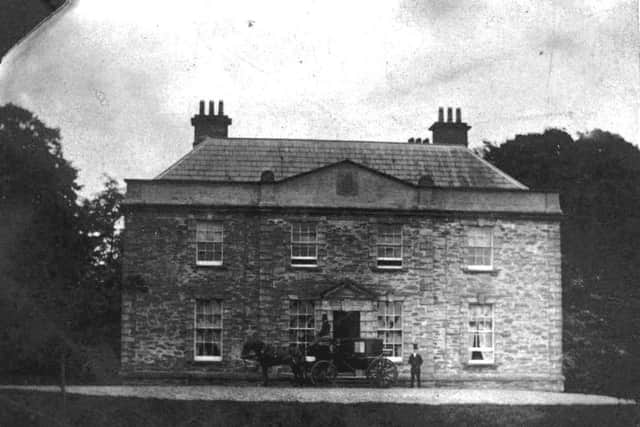Early Georgian country house’s link to shocking Strabane execution


The reassessment of Prehen House came about as a result of a major survey of historic buildings which NIEA and its predecessor the Environment and Heritage Service had been undertaking across the province since 1997.
The surveyors had singled out the survival of the interior fixtures in the building, such as door and window surrounds and chimney-pieces which normally would have been removed by the Victorians to keep up with the fashions of the day.
PREHEN AND THE GERMAN OFFICER (1915)


Advertisement
Advertisement
A search through the old News Letters from bygone days shed interesting aspects of Prehen House’s history.
The News Letter reported in May 1915 that the town clerk of Londonderry writing to the Home Office, at the request of the Mayor, had suggested that the residence and property which belonged to German army officer Baron George Carl Otto Louis von Scheffler Knox through marriage, should be used by the military authorities for the reception of wounded soldiers.
The News Letter reported: “Prehen House has been unoccupied since the commencement of the war, the owner having left Londonderry on the eve of the declaration of war by Great Britain against Germany, and he is now serving with the German army.
“If Prehen House is utilised by the military authorities for convalescent wounded soldiers the Mayor is assured that the ladies of Derry would provide all the necessary nursing and other arrangements, and be glad of helping those who are suffering so much for King and Country.”


Advertisement
Advertisement
The News Letter then added further details on the house’s connection with the German officer: “Captain von Scheffler is married to a relative of the late Colonel Knox, DL, who was the former owner of Prehen. Colonel Knox willed the property to Colonel von Scheffler on certain conditions, one of which was that Captain von Scheffler would become a British subject within a year of Colonel Knox’s death. Captain von Scheffler complied with all the conditions, except this one, but when the matter came before the High Court he pleaded that as an officer of the German army it was impossible for him to fulfil the condition in the time, and the High Court waived the condition, with the result that he became absolute owner of the property. The rents for the Prehen estate are being collected by a gentleman who is under bond to account for them to the government.”
PREHEN WOOD SOLD TO TIMBER MERCHANTS (1929)
Some 14 years later in January 1929 that the News Letter reported that Prehen Wood had been sold to Messrs James McGregor and Son, who were Belfast timber merchants.
The News Letter commented: “A scheme for rescuing the demesne from the sawyer by converting it into a public park for London came to nothing.”


The property was put up for sale by private treaty of the total acreage of 200, some 86 acres were bought by adjoining tenants.
Advertisement
Advertisement
Messrs McGregor’s lot had comprised Prehen House and the ground between it and the Prehen Road.
Noted the News Letter: “This they acquire the great bulk of the magnificent old trees which fringe the road, and provide one of the most picturesque views about Londonderry.”
The sale took place by direction of Mr W E McClatchy, secretary of the Land Purchase Commission, under the Northern Ireland Ministry of Finance.
“Mr McClatchy is official custodian of alien enemy property in Northern Ireland,” the News Letter commented.
Advertisement
Advertisement
And further details were given of the von Scheffler’s departure from Prehen House on the eve of the Great War: “Colonel and Mrs von Scheffler were actually in residence in Prehen House and were entertaining a luncheon party when the colonel got a telegram summoning him to join his regiment in Germany. He and his wife left hurriedly.”
But it was also noted: “Owing to his connection with Londonderry, Colonel von Scheffler, who was in charge of a prisoners camp during the war, acted with particular consideration towards Derrymen who were unfortunate to be taken prisoner.”
FATE OF ‘HALF-HANGED’ MACNAUGHTEN (1761)
The News Letter, in this edition of the paper, also provided a fascinating snippet of the tragic historic which is connected with Prehen House.
The newspaper reported: “It was on the road through Prehen Wood that, a century ago, a man named MacNaughten fatally shot Miss Knox, the daughter of the then owner. He father was removing her from MacNaughten’s influence and the shot which killed her was intended for her father.”
Advertisement
Advertisement
Out of curiosity (and nosiness on my part) I had to have a further hunt around the internet and in the old newspapers to see if I could find any further details concerning the tragic Miss Knox and the murderous MacNaghten. And there was plenty to interest me.
Rather, than the murder occurring in the 1820s, as was stated in the News Letter in 1929, the murder of Miss Mary Ann Knox occurred in November 1761 and MacNaughten was subsequently hung for her murder at Strabane on December, 16, 1761.
But it was hanging which he gained a notorious nickname “half-hanged MacNaughten” as the rope they used to hang him broke on the first attempt and left him . . . “half-hanged”.
The online Dictionary of National Biography, 1885-1900, Volume 35, provides an interesting biography of MacNaughten. It has this to say: “Son of a gentleman seated at Benvarden, near Ballymoney, Co Antrim. The father died when his son was about six, leaving him an estate worth 500l. a year. He was educated at Dublin University, but does not appear to have graduated. At college his handsome figure and insinuating address attracted the notice of Sir Clotworthy Skeffington, fourth Viscount Massereene, who introduced him to the best society.
Advertisement
Advertisement
“His passion for gaming soon involved him in debt, but he retrieved his fortune by marrying the sister of Lord Massereene’s second wife, a daughter of Henry Eyre of Rowtor, Derbyshire, whose friends made him take an oath that he would play no more.
“About two years later, however, he returned to the gaming-table with more disastrous results than before.
“An attempt to arrest him for debt so alarmed his wife, who was lying-in, that she died soon afterwards.
“Reduced to distress, he obtained through Massereene’s good offices the place of collector of the king’s duty in Coleraine, Co Londonderry, worth about 200l. a year.
Advertisement
Advertisement
“He gambled away more than 800l. of the king’s money, and in consequence lost his collectorship, and his estate was sequestered.”
I did some further searching through the News Letter from 1761 to see if the paper had reported on his execution. And in the edition of December, 22, 1761 there was a hard to decipher report from Strabane on December 16, 1761 which confirmed the story that MacNaughten had indeed been ‘half-hanged’.
The report read: “Strabane, December 16, “This day, agreeable to his sentence, John MacNaughten, Esq, for the murder of Miss Kox, and [John] Dunlap, his unfortunate accomplice, were executed in the middle of the great road leading from Lifford.
“Mr MacNaughten bore with surprising resolution and courage at the place of execution; and forgave and begged forgiveness of his prosecutors.”
Advertisement
Advertisement
The News Letter report added that: “Mr MacNaughten made so violent a jump on the ladder that he broke the rope and fell to the ground. He was then raised and seated on a cart, till another rope was brought.”
On the second attempt MacNaughten was successfully executed. Their bodies were then handed over to friends and they were “buried in one grave in a corner of the churchyard”.
The News Letter’s report also detailed that two other alleged accomplices of MacNaughten, named Irwin, had been arraigned the previous Saturday for the same murder and pleaded not guilty. They argued that they were not prepared for trial and where therefore recommitted to Omagh gaol, “where they must be until next assizes”.
Life at Prehen House continued, and each year on the anniversary of Mary Ann’s death, her mother would retire to her room to lament her daughter’s death. She eventually recovered from her grief with the marriage of Mary Ann’s brother George to Jane Mahon of Strokestown, Co Roscommon, and this girl became as a second daughter to her. For 170 years the Knox family lived at Prehen, during which the house and estate were passed down the generations from father to eldest son.